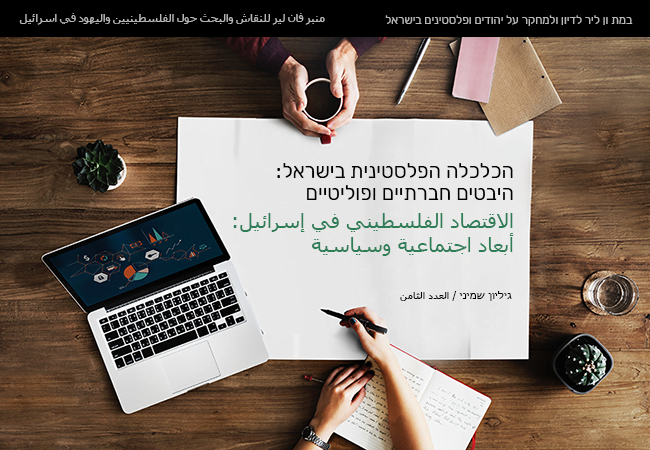In recent years, a “partnership-based peace” approach has evolved in both research literature and civil society as a leading paradigm for the resolution of the Israeli-Palestinian conflict, or more accurately, for Zionist-Palestinian reconciliation. This paradigm contrasts with the predominant perception of peace, which is based on the separation to two nation-states with aspirations for ethnic-demographic and spatial separation between Israeli-Jews and Palestinian-Arabs. This prevalent view can be succinctly described by the saying “Us here, them there.” At the same time, the partnership-based peace paradigm that we are advancing here differs fundamentally from the notion of a single secular or civic state spanning the area from the Mediterranean Sea to the Jordan River, an approach which relies on a political framework that grants equal individual rights and supra-national identity.
Unlike the one-secular-state solution, the new paradigm acknowledges the existence of two national groups – the Jewish-Israeli and the Arab-Palestinian – as a political and cultural reality unlikely to change soon. Contrary to the classic two-state solution, this new paradigm believes that it is neither feasible nor appropriate to strive to eliminate the de-facto demographic intermingling present in most parts of the country, which would persist even after a territorial division into two states. Furthermore, it does not deny the cultural, religious and national ties of both nationalities to the entire region between the Jordan and the sea and does not attempt to hide this fact. Concurrently, this novel approach recognizes the necessity to halt the Jewish colonial takeover between the Jordan and the sea and to amend the institutions and laws that ensure Jewish dominance across the territory.
Considering these assumptions and given the equal rights of both peoples to self-determination, we posit that the most feasible and appropriate blueprint for peace should be rooted in an equal political partnership between the two. The right of both peoples to self-determination in the framework of separate states is recognized in international law. As such, a political partnership between them could manifest in the form of an Israeli-Palestinian confederation, akin to the Israeli-Palestinian union proposed in UN resolution 181 from 1947. Alternatively, it could take shape within a bi-national state on the model of a consociational democracy or a federation.
This paradigm, which centers on a partnership-based arrangement of relations between the two nations, diverges not only from familiar frameworks often envisioned for Israeli-Palestinian peace but also challenges the prevalent model of a democratic nation-state built on majority rule with constitutional protections for human rights. A prevailing approach to resolving collective conflicts currently views democratic power-sharing as a more fitting democratic model for regions marred by group conflicts than the conventional democratic model. Accordingly, the partnership-based peace paradigm can manifest through a combination of internal and supra-state powers as an appropriate framework for resolving the conflict.
It’s crucial to highlight that the partnership-based model does not seek to dismantle the state framework as such. Instead, it acknowledges that the “ethnocratic” nation-state, which has been the local governing framework to date and which facilitates the realization of Jewish control and dominance, inherently perpetuates the conflict. This realization necessitates exploring alternative regime models. These models would steer clear of the fictitious conflation of citizenship, ethnicity and territory, and instead, promote fair arrangements between nationalities entitled of self-determination in the same space.
However, despite increasing acknowledgment of the merits of a political framework grounded in equality and partnership, it seems that the conditions that would facilitate adopting this model in contemporary Israel/Palestine seem absent, let alone factors that would ensure its sustained stability. These challenges become even more evident in light of the recent “regime coup” led by Israel’s government. These actions signify a direct affront to human rights and minority rights at large, specifically targeting the rights of Palestinians on both sides of the Green Line.
Beyond recent developments, scholarly literature posits that pivotal conditions for the acceptance and stability of an agreement founded on peace and partnership encompass a lack of extreme disparities in political power and socio-economic standing, a shared identity, and a history of collaboration among elites.
Contrarily, the trajectory in Israel/Palestine appears to starkly contrast this ideal. Significant power disparities persist between Israeli-Jews and Palestinian-Arabs, evident in the ongoing Israeli-Jewish colonization and expansion throughout the space between the Jordan and the Mediterranean; socio-economic divides; and Jewish dominance of security forces and mobility across this region. Simultaneously, there’s a notable absence of both shared identity and consciousness. Prominent forces within both political identities not only remain entrenched in their adversarial positions but thrive on the conflict. In addition, there is a lack of historical experience of collaboration between the political elites, which joins a deep distrust among the general public.
The conclusion that existing conditions in Israel/Palestine do not support the model of partnership is accompanied by the problem of a limited political imagination and cultural repertoire. Even though the partnership paradigm as a preferred way of solving the conflict is not new, our fundamental perceptions – in light of which we understand and interpret reality, and in light of which various actors understand the realm of possibilities for changing and repairing this reality – are still limited. For example, the perception of the conflict as a territorial struggle between two national movements, which is prevalent in Israeli society, and the perception of a territorial partition or a demographic separation as a solution to the conflict, both withhold the ability to identify the conflict’s root causes. These underlying problems include the roots of the conflict also within the Green Line, from the period of the “Nakba” to this day; the need to resolve the refugee question; and the deep ethno-social gaps that continue to characterize the conflicted space. Simultaneously, the view held by a significant number of Palestinians that ending the conflict depends on the physical or political nullification of Israel, as well as the expanding boycott movements, block possibilities to talk, to develop understandings, and to upgrade the collaboration between the groups.
Nevertheless, and despite the difficulties described above, we argue that the dire condition of Israel/Palestine in the face of the consolidation of an apartheid regime between the Jordan and the sea has no other solution than a partnership-based reconciliation. The space in which both nationalities find themselves is indeed mixed throughout, and both of them have a firm and valid historical, cultural and political connection to the very same homeland. These are basic conditions that make a new political imagining possible. Therefore, in our view, in the face of absolutist visions in the spirit of Jabotinsky’s poem “She is All Mine,” or conversely, visions of a rigid separation, it is time to articulate a future that exceed the national-colonial binarism, a future that encourages an equal cultural and identical development, that is integrated on the local, regional, state and supra-state levels. We argue that the absolutist and limited political imagination significantly hinders the progress of peace in the region and stokes the flames of distrust against the possibility of peace and reparation, a distrust that has been growing ever-deeper in recent years. At the same time, the limited imagination prevents any investment in foundational measures on the level of the community, the economy, education, and politics, that could improve the chances of establishing peace. In the face of these negative forces, the proposed model of a partnership in political power and in the territory of the homeland is not just a forward-looking vision, but also a groundwork for advancing of common interests for both communities on all levels, and thus a rallying political force for moving toward reconciliation.
The need to enhance the political and cultural imagination and syntax for the sake of a partnership-based vision of reconciliation led us to launch a multidisciplinary think tank that would study the subject from various aspects and based on varied fields of expertise and knowledge. The challenge we set ourselves was twofold: first, to develop an analytical, terminological and theoretical framework that fits the paradigm proposed here; and second, to develop a “theory of change” that fits the paradigm of partnership-based peace, including an expansion of the range of relevant possibilities with respect to processes, policy making, initiatives, projects, and types of discourse. These stand to contribute to the creation of the conditions needed to establish stable democratic arrangements of a partnership in the government of Israel/Palestine on the level of the state, the region, and the municipality.
The essays featured in this issue of Minbar are a preliminary attempt to put in writing some of the insights we have reached in this thinking group. We recognize that these are initial and sometimes still raw ideas. They fit the goal of the present publication – namely, to set in motion a crucial process of developing the discourse and expanding the thinking, the imagination, and the comparative observation on this topic.
Limor Yehuda, in her essay “How to Transition to a Political Partnership in Israel/Palestine?,” describes the enormous challenges involved in any attempts to reach a partnership-based peace in the present reality. In light of these challenges, Yehuda proposes to examine three types of processes that seem feasible even in the present political reality, and which stand to contribute to the creation of the conditions that support the establishment of peace based on equality and partnership.
Ameer Fakhouri, in his essay “Constructing Identity and Group in Relation to the Predicament and the Space: Preliminary Analytical Notes,” proposes an analytical and terminological framework for the construction of a collective identity. This framework provides theoretical, explanatory and transformational tools that help identify, understand, explain or create an imagining shared by all the inhabitants of the land. It is an imagining based on mutual dependence in its various manifestations, combined with an evolving geographical image of a shared homeland.
Oren Yiftachel, in his essay “The Colonial Condition and Zionist-Palestinian Reconciliation,” points to the need to acknowledge the colonial process – in which the Jewish group continues to expand its control over the Palestinian space – as one of the roots of the conflict. He argues that a vision of decolonization is required, and that the first step toward realizing it is a change of discourse. This change is achieved primarily by reshaping the concepts that researchers, the media, artists and other figures who shape the public space use to describe the conflict. It also requires a bi-national collaboration in the creation of a new vocabulary and political imagination whose goal is to replace ethnic supremacy with equality and historical reparation. This reparation is especially crucial in these days of “regime coup” and escalation of Jewish supremacy discourse.
As’ad Ghanem, in his essay “Toward a Stable Resolution in Palestine: What and How?,” calls for a redrawing of the battle to stop the process of colonial occupation and eradicate the condition of apartheid in Palestine. Contra the view that it is not the responsibility of the victim to propose a way out, Ghanem argues that Palestinian elites, within the Green Line and beyond it (Palestinian exiles included), have a crucial role in this process. According to him, the basic interest of the Palestinians is to change the situation and help bring about the beginning of a process, however long, aimed at reaching a fair resolution in Palestine.
Meron Rapoport, in his essay “From the Margins to the Public Debate: The Confederation Idea in Israeli Discourse,” presents a kind of personal and political travel journal in which he describes how the vision of a confederation took shape and how it continues to evolve. It is a vision of a partnership between the two nationalities in a single homeland, conceived as an alternative to the vision of two separate states. Rapoport documents the ongoing and partially successful efforts of the movement Eretz LeKhulam (“A Land for All”) to infuse the familiar discourse of ethno-national separation with ideas of political partnership, freedom of movement, and a recognition of the ties of both nationalities to the shared homeland.
Avner Dinur, in his essay “Reconciliation as a Demand for a Change in Identity,” takes issue with the prevalent discourse according to which historical narratives are the private business of each respective side and no woman nor man has the right to challenge the stories told by their friends. According to Dinur, the process of reconciliation requires the identities of both parties to change in two central ways that challenge the “sanctity of narratives”: reconciliation as a recognition of the other, and reconciliation as a demand for change.
Yehezkel Lein, in his essay “‘Go Out and Learn’: Reflections on the Possibility of Settlers Remaining in the territory of a Palestinian State,” argues that a comparative-historical analysis shows that in most of the cases involving settlements that are geographically adjacent to the settling mother country, the settlers were able to remain in place as part of the new policy enacted after a process of decolonization. Lein describes the development of diverse patterns of co-existence between the groups in the cases of Kosovo, Estonia and Namibia, and the main reasons that large groups of settlers remained in the colonized areas even after the retreat of the colonizing mother country.
Thabet Abu Rass, in his essay “Israel/Palestine: From Jewish Supremacy to Equality in a Shared Space,” details the ways in which the political geography of the Israeli-Palestinian space has become mixed and difficult to untangle or pry apart, while at the same time, the military occupation and Jewish settlement have continued. He argues that this reality of a mixed population forces the international community, the Palestinian leadership and the Israeli leadership alike to abandon the failed idea of separation and a partition of the land, that failed to succeed, to think outside the box, and to advance a discourse toward the establishment of a bi-national confederation between the Jordan and the sea.
Michal Braier, in her essay “Partnership-Based Civil-Urban Planning: A Re-Planning of the Neighborhood of Issawiye,” sketches a preliminary outlines for action toward a civil-urban partnership in the Jerusalem sphere that promotes a decolonization of the practice of urban planning. By focusing on the planning of the spaces of this neighborhood, Braier shifts the weight of the discussion about Jerusalem from its lofty dimensions to more mundane considerations, in an attempt to facilitate an urban existence based on equality and respectful expression to both national communities that already inhabit the city side by side.
Menachem Klein, in his essay “Jerusalem: Two Capitals and an Urban Confederation,” argues that the starting point for a solution based on a partition into two states must be the quality of the texture of the urban life in Jerusalem/Al-Quds. Klein adheres to the two-state solution, but moderates it by focusing on the administration of the future urban borderline as a “soft” border. The administration of the border must allow for the natural flow of urban life while also being responsive to the geographical and social realities on both of its sides.
Mei-Tal Nadler, in her essay “1948 and the Archive of Tomorrow: On Literary Ethical-Political Imagination and its Limits,” shines a spotlight on literary works from recent decades that re-open the story of 1948. According to Nadler, in the archiving action they propose, these works open up a new horizon for deep processes that stand to expand the field of democratic battles and to bolster Jewish-Palestinian civil collaborations.
Ron Dudai, in his essay “Everyone’s Heroes? Violence, Rescue, and the Potential for Shared Spaces of Commemoration,” points to the potential inherent in giving greater presence in the public space and discourse to stories of “cross-national” rescues. These are stories of cases in which Palestinians rescued Jews in situations of crisis, and vice versa. By presenting these stories, Dudai suggests a tool for constructing a more beneficent consciousness that in turn, diminish the hatred and support the process of reconciliation between the two peoples.
Alexandra Herfroy-Mischler, in her essay “Pre-Transitional Justice? Grassroots Collaborations in Israel/Palestine,” examines the relevance of the field of transitional justice to the Israeli/Palestinian context. According to her, so long as the violence and extensive human rights violations continue in Israel/Palestine, the processes of transitional justice commonly advanced in reconciliation theories are not available. At the same time, she points to the possibility of enacting processes of “pre-transitional justice,” and demonstrates how this action is being realized in recent years in a variety of civil society initiatives.
Yoav Shemer-Kunz, in his essay “Europe and a Partnership-Based Peace in Israel/Palestine,” argues that the European Union may have a key role to play in advancing Israeli-Palestinian peace. To date, the official European policy about the conflict and the way of solving it is largely declarative and symbolic, and its effect on the reality on the ground is marginal. This predicament can change, and should change. Europe, based on its expertise and experience, can offer the Israeli and Palestinian leaderships alternative ways to cope with the bi-national reality and to end the apartheid regime, by adopting successful European models of shared political power in mixed areas.

















